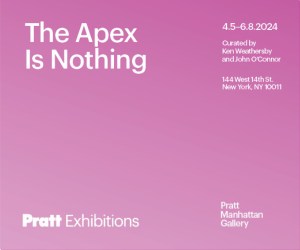Contributed by Jonathan Stevenson / Just about every piece in Nicole Eisenman�s nobly minatory exhibition �Al-ugh-ories� at the New Museum, up through June 26, pulses with aesthetic energy, turbocharged by a peripatetic erudition that darts assuredly from one caustic historical (sometimes art-historical) reference point to another. The artist is centrally, though not exclusively, concerned with civilizational discord, and in particular, it seems, with American decline. If the resurgence of representational painting needed vindication, Eisenman�s work, in its substantive sweep and technical felicity, would provide it. It’s also bracing to find an artist, in counterpoint to the trend towards the conceptual and visually reductive, who is so firmly committed to expansiveness and specificity.
[Image at top: Nicole Eisenman, Commerce Feeds Creativity, 2004, oil on canvas. Hoyt Family Collection.]
Some pieces are agreeably transparent and straightforward in their acidulousness, � la George Grosz. In Tea Party (2011), made in response to a challenge by Jerry Saltz, a haggard (possibly drunk) Uncle Sam sits alongside four companions � including a rifle-toting young woman, a bomb-maker, and a sleeping dog � in a bunker filled with shelves of survivalist staples. An unshaded light bulb shines over his head, implying that it is now Uncle Sam who should be interrogated. The Triumph of Poverty (2009), a renowned painting, recapitulates Hans Holbein the Younger�s sixteenth-century work of the same name � an allegorical painting par excellence. In this piece, Eisenman sneers cheerfully at the cyclical as opposed to progressive character of history. Some 400 years on, an inoperative car has supplanted mules, as people in various visible forms of distress or privation adorn an inert heap, unable to go anywhere. Compounding the tragedy is delusion: a tuxedoed man�s ass is literally backwards, yet this pompous miscreant of a burgher seems to control tiny subjects on a string.
Then there are more opaque works. Night Studio (2009), for example, visually registers both sexual ambiguity and role reversal with a sly mixing and matching of the body parts of the presumptive artist and model, one figure a roseate pink and the other a Gauguin yellow, who are reclining on a bed. The painting includes images of books about older artists and a pack of Camels, famously Philip Guston�s brand, hinting at intimate relationships that transcend time that contemporary artists are able to forge with their predecessors thanks to the multitude of images they can now access. With Coping (2008), in its embrace of an entire village and its Munch-like lugubriousness, Eisenman eases from personal to existential strife. A notional volcano has bogged down a valley community�s inhabitants: they are mired waist-deep in what looks like thick lava beneath a baleful yellow sky. Into these novel and distressing circumstances Eisenman introduces iconic characters from old paintings and popular culture. The intent seems both symbolic and declaratory. A mummy may signify obliviousness, a naked woman innocence. Everyone, whether human or imaginary, is affected.
In one corner of the east room, Eisenman takes a glistening scythe to the American Dream. Anchoring that part of the exhibition is a deliciously nasty little painting called Dysfunctional Family (2000). In warm sepia tones that customarily connote nostalgia, she depicts a mother lounging in an armchair, languidly knitting with her naked crotch exposed while her buttoned-down husband sits at his desk firing up a bong. Their little boy sits beneath them, quizzically eyeing his own crotch, having mutilated his penis with a meat-tenderizing mallet. The painting is tactically small, requiring close scrutiny. Once viewers decipher it, they tend to shudder. Then they might chuckle at the realization that the traditions and habits that people and cultures accumulate can�t all be harmonized or tamed or rendered virtuous, and at the often gormless compulsion to domesticate them. Other paintings, like the quite recent Selfie (2014), which has a clunky, Guston-esque quality, are less harsh, merely looking sidelong at postmodern triviality, vanity, and self-delusion.
Eisenman�s work is not especially painterly or tactile: it does not evoke wonder about why she chose a particular brushstroke or how she built up a certain canvas � or, therefore, about the idiosyncrasies of her mind or her process. She is, instead, a winningly imperious and extroverted painter, expertly employing line and composition, using color to editorialize, and judiciously selecting content so as to hold forth confidently about the world and how it should be apprehended. Her artistic ego may be big, but it’s also generous. The overarching tone of her work is paradoxically warm sarcasm. Unlike most sarcasm, hers is urgent rather than offhand. At the same time, her native itinerancy staves off excessive thematic rumination and helps save her work from being didactic or heavyhanded. The coyly maladroit pun in the show�s title seems to record the suspicion that the fables that customarily deploy outlandishly dire fantasies to illuminate human travails are verging closer to reality. Sadly, it�s a credible position, and Eisenman stakes it out with humor, ruefulness, and poignancy. She has taken it upon herself to be an artist of her time, and boldly succeeded.
“Nicole Eisenman: Al-ugh-ories,” curated by Helga Christoffersen and Massimiliano Gioni. New Museum, LES, New York, NY. Through June 26, 2016.
Related posts:
The strategic now (2014)
Quote of the Day: Nicole Eisenman (2009)
Nicole Eisenman in Berlin (2008)
America’s Lessness (2008)
——
Two Coats of Paint is licensed under a Creative Commons Attribution – Noncommercial-No Derivative Works 3.0 United States License. To use content beyond the scope of this license, permission is required.


























I disagree with one comment in your interesting and enlightening review. I think Nicole Eisenman is a wonderful painter in ways photography cannot illustrate. To me the brushstrokes, textures and painterly effects are brilliant. And, where appropriate to her intention, they help her humor come through. Take, for example, the heavy impasto shit-colored clouds that float improbably in front of the houses in "Coping." In other paintings not illustrated here they are simply beautiful. anyone who loves painting should see this show before it closes next week.